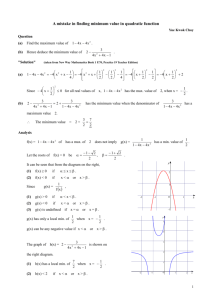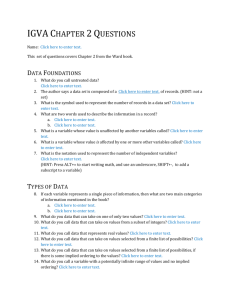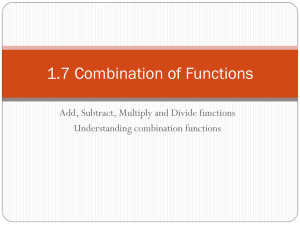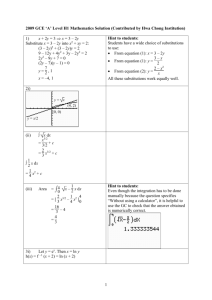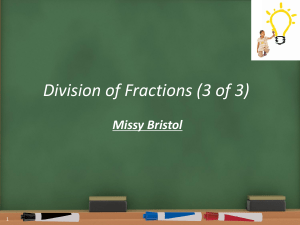Difference method for some finite algebraic series
advertisement
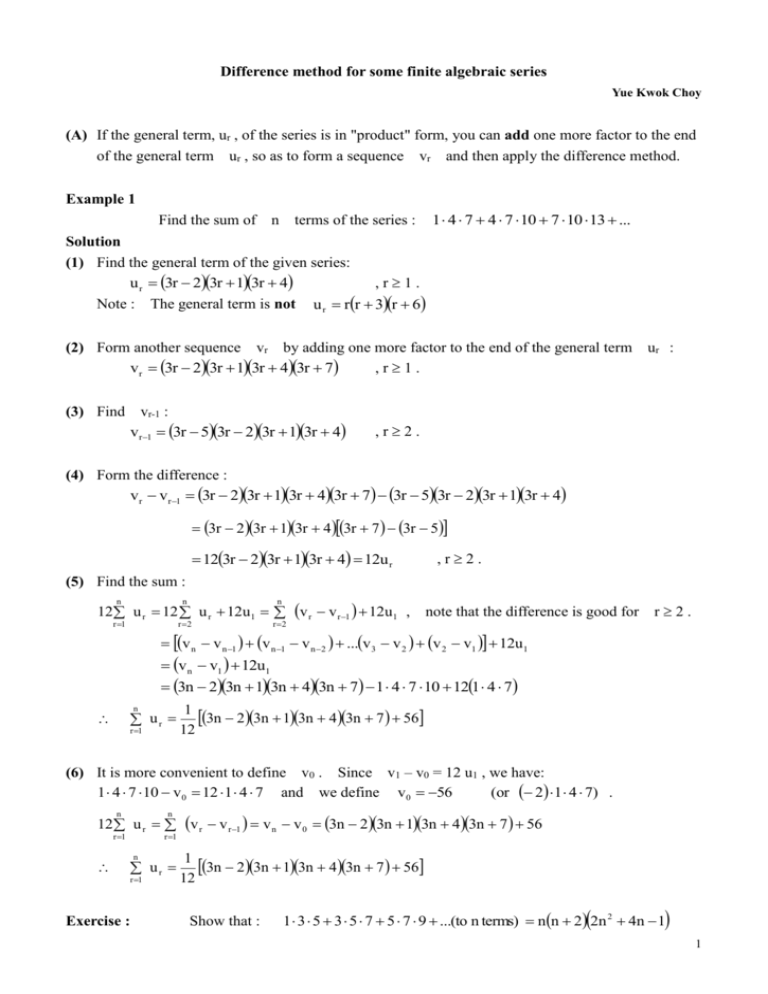
Difference method for some finite algebraic series Yue Kwok Choy (A) If the general term, ur , of the series is in "product" form, you can add one more factor to the end of the general term ur , so as to form a sequence vr and then apply the difference method. Example 1 Find the sum of n terms of the series : 1 4 7 4 7 10 7 10 13 ... Solution (1) Find the general term of the given series: ,r1. u r 3r 23r 13r 4 Note : The general term is not u r rr 3r 6 (2) Form another sequence vr by adding one more factor to the end of the general term ur : ,r1. v r 3r 23r 13r 43r 7 (3) Find vr-1 : v r1 3r 53r 23r 13r 4 ,r2. (4) Form the difference : vr vr1 3r 23r 13r 43r 7 3r 53r 23r 13r 4 3r 23r 13r 43r 7 3r 5 123r 23r 13r 4 12u r ,r2. (5) Find the sum : 12 u r 12 u r 12u1 v r v r 1 12u1 , note that the difference is good for r 2 . n n n r 1 r 2 r 2 v n v n 1 v n 1 v n 2 ...v 3 v 2 v 2 v1 12u1 v n v1 12u1 3n 23n 13n 43n 7 1 4 7 10 121 4 7 n ur r 1 1 3n 23n 13n 43n 7 56 12 (6) It is more convenient to define v0 . Since v1 – v0 = 12 u1 , we have: 1 4 7 10 v 0 12 1 4 7 and we define v 0 56 (or 2 1 4 7) . 12 u r v r v r 1 v n v 0 3n 23n 13n 43n 7 56 n n r 1 r 1 n ur Exercise : r 1 1 3n 23n 13n 43n 7 56 12 Show that : 1 3 5 3 5 7 5 7 9 ...(to n terms) nn 22n 2 4n 1 1 (B) If the general term, ur , is in "quotient" form, you can remove one more factor at the end of the general term ur , so as to form a sequence vr and then apply the difference method. Example 2 Find the sum of n terms of the series : Solution (1) Find the general term of the given series: 1 ur 3r 23r 13r 4 1 1 1 ... 1 4 7 4 7 10 7 10 13 ,r1. (2) Form another sequence vr by removing one factor at the end of the general term ur : 1 ,r1. vr 3r 13r 4 (3) Find v r 1 vr-1 : Note that 1 4 v0 denominator. 1 3r 23r 1 ,r1 is well-defined and that is why in (2), we remove the first factor in the Removing (3r + 4) instead in the denominator will get v0 undefined . (4) Form the difference : v r v r 1 1 1 3r 13r 4 3r 23r 1 1 3r 2 3r 4 3r 23r 13r 4 6u r ,r2. (5) Find the sum : 6 u r v r v r 1 v n v 0 n n r 1 r 1 1 1 3n 13n 4 4 n 1 1 1 ur r 1 6 4 3n 13n 4 Exercise : Prove that : 1 1 1 1 1 ... (1) 1 2 3 2 3 4 n n 1n 2 4 2n 1n 2 n (2) r 1 1 1 1 1 2r 12r 12r 3 4 3 2n 12n 3 2 (C) More complicate finite series can be broken into two (or more) series and each can be handled by the methods above . Example 3 Find the sum of n terms of the series : 1 4 7 8 4 7 10 11 7 10 13 14 ... Hint The general term, u r 3r 23r 13r 43r 5 3r 23r 13r 43r 7 2 3r 23r 13r 43r 7 23r 23r 13r 4 1 3n 23n 13n 43n 7 2n 5 28 10 Answer Example 4 Find the sum of n terms of the series : 3 5 7 ... 2 3 4 5 3 4 5 6 4 5 6 7 Hint The general term, ur 2r 1 r 1r 2r 3r 4 Answer 2r 1 1 2 1 r 1r 2r 3r 4 r 2r 3r 4 r 3r 4 5 1 3n 5 72 3 n 2n 3n 4 (D) If the general term, ur , of the series is in "product + quotient" form with same number of factors in numerator and denominator, you can add one more factor to the end of the general term ur , so as to form a sequence vr and then apply the difference method. Example 5 Find the sum of n terms of the series : 2 24 246 ... 1 1 3 1 3 5 2 4 ... 2r 2 4 ... 2r 2r 2 , vr 1 3 ... 2r 1 1 3 ... 2r 1 Hint ur Answer 1 2 4 ... 2r 2n 2 2 3 1 3 ... 2n 1 3
